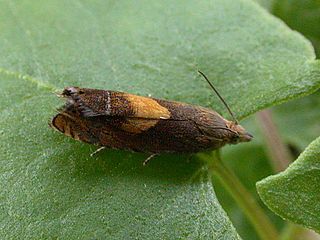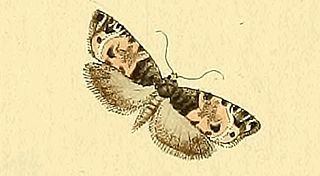
Agapeta hamana is a moth of the family Tortricidae. It is found in Europe, western and southern Siberia, the Caucasus, Kazakhstan, Transcaucasia, Asia Minor, Central Asia, Iran, Afghanistan, Mongolia, western China and northern India.

Dichrorampha petiverella is a moth of the family Tortricidae. It is found in the Palearctic realm.

Notocelia rosaecolana is a moth of the family Tortricidae. It is found in the Palearctic realm, where it has been recorded from China, Mongolia, Korea, Japan, Iran, Central Asia, Russia and Europe.

Epinotia tedella is a moth of the family Tortricidae. It is found in Europe.

Spilonota ocellana, the bud moth, is a moth of the family Tortricidae. It is found in the Palearctic realm, from North Africa and Europe to Iran, eastern Russia, China, Korea, and Japan. It is also present on Madeira and in North America.

Epinotia nanana, the European spruce needleminer, is a moth of the family Tortricidae. It is found from northern and central Europe to Russia and Mongolia.

Rhopobota naevana, the holly tortrix moth, holly leaf tier or blackheaded fireworm, is a moth of the family Tortricidae. It is found from Europe to eastern Russia, China, Taiwan, Mongolia, Korea and Japan. It is also present in India, Sri Lanka and North America.

Rhyacionia pinivorana, the spotted shoot moth, is a moth of the family Tortricidae. It is found from northern and central Europe to eastern Russia, China, Korea and Japan.

Grapholita compositella, the clover seed moth, is a moth of the family Tortricidae. It is found from Europe to Asia Minor, Mongolia, China and eastern Russia. It is also present in North America.

Pammene regiana is a species of moth of the family Tortricidae. It was described by Zeller in 1849. It is found in most of Europe, except the Iberian Peninsula, most of the Balkan Peninsula, Lithuania and Ukraine.

Cochylichroa atricapitana, the black-headed conch, is a moth of the family Tortricidae. It is found in China (Xinjiang) and the eastern Palearctic and most of Europe.

Ancylis myrtillana is a moth of the family Tortricidae. It was described by Treitschke in 1830. It is found in most of Europe and across the Palearctic.It has also been recorded in North America. The habitat consists of moorland.

Grapholita janthinana, the hawthorn leafroller, is a moth of the family Tortricidae. It was described by Philogène Auguste Joseph Duponchel in 1843. It is found in most of Europe, except most of the Balkan Peninsula, Ukraine, Lithuania and Estonia. The habitat consists of hedgerows, gardens and woodland edges.

Gynnidomorpha alismana, the water plantain conch, is a moth of the family Tortricidae. It was described by Ragonot in 1883. It is found in most of Europe, except Spain, Switzerland, most of the Balkan Peninsula and Ukraine. Further east it is found across the Palearctic to China and Korea. It is found in riverine and other watery habitats.

Cochylis pallidana, the sheep's-bit conch, is a moth of the family Tortricidae. It was described by Zeller in 1847.

Cochylimorpha straminea, the straw conch, is a species of moth of the family Tortricidae. It is found in most of Europe, Morocco, Algeria, Tunisia, Asia Minor, the Palestinian territories, Iraq, Syria, Armenia, Transcaspia, Turkmenistan and Iran.

Gynnidomorpha permixtana, the coast conch, is a moth of the family Tortricidae. The species was first described in 1775 by the Austrian lepidopterists, Michael Denis and Ignaz Schiffermüller. The moth is found in Asia and Europe.

Epinotia nemorivaga, the bearberry bell, is a species of moth in the family Tortricidae. It is found in Europe and Asia.

Eucosma aspidiscana, the golden-rod bell, is a species of moth of the family Tortricidae. It is found in China, Mongolia, Korea, Japan, Russia, North Africa and most of Europe. The habitat consists of woodlands, downland, waste grounds and cliffs.

Notocelia incarnatana, the chalk rose bell, is a species of moth of the family Tortricidae. It is found in China, Mongolia, Japan, Russia, Kazakhstan and Europe, where it has been recorded from most of the continent, except parts of the Balkan Peninsula.





















